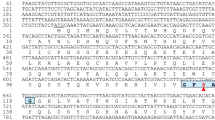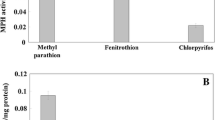Abstract
The coding region of mpd gene corresponding to mature methyl parathion hydrolase (MPH) was heterologously overexpressed in Escherichia coli BL21 (DE3) by using pET expression system. The lactose-induced expression yield of MPH is increased 2-fold compared with IPTG as inducer. Furthermore, it was found that specific activity of MPH increased 48% by reducing the induction temperature to 22°C. The addition of 25 mM lactose at 22°C, the MPH activity of fermentation broth had a specific activity of 1.4 × 104 U/mg protein. Plasmid was no significant decrease in the modified medium. The optimal pH and temperature of MPH were 8.0 and 30°C, respectively. Over a period of 5 months, the dried cells showed no significant decrease in the activity of the detoxifying enzymes. The crude enzymes in 50 mM citrate-phosphate buffer (pH 8.0) were able to degrade about 98% of the organophosphate pesticides sprayed on cabbage. The detoxification efficiency was superior to that of the treatments of water, detergent, and a commercially available enzyme product. Additionally, the products of pesticide hydrolysis generated by treatment with the enzyme extract were determined to be virtually nontoxic.







Similar content being viewed by others
References
Bradford MM (1976) A rapid and sensitive method for the quantitation of microgram quantities of protein utilizing the principle of protein-dye binding. Anal Biochem 72:248–254
Cui ZL, Li SP, Fu GP (2001) Isolation of methyl parathion-degrading strain M6 and cloning of the methyl parathion hydrolase gene. Appl Environ Microbiol 67:4922–4925
Fu GP, Cui ZL, Huang T, Li SP (2004) Expression, purification, and characterization of a novel methyl parathion hydrolase. Protein Expr Purif 36:170–176
Knappik A, Krebber C, Pluckthun A (1993) The effect of folding catalysts on the in vivo folding process of different antibody fragments expressed in E. coli. Biotechnology 11:77–83
Kosinski MJ, Bailey JE (1991) Temperature and induction effects on the degradation rate of an abnormal beta-galactosidase in E. coli. J Biotechnol 18:55–68
Laemmli UK (1970) Cleavage of structural proteins during the assembly of the head of bacteriophage T4. Nature 227:680–685
Monteiro R, Souza EM, Yates MG, Pedrosa FO, Chubatsu LS (2000) Use of lactose to induce expression of soluble NifA protein domains of Herbaspirillum seropedicae in E. coli. Can J Microbiol 46:1087–1090
Neubauer P, Hofmann K (1994) Efficient use of lactose for the lac promoter-controlled overexpression of the main antigenic protein of the foot and mouth disease virus in E. coli under fed-batch fermentation conditions. FEMS Microbiol Rev 14:99–102
Rani NL, Lalithakumari D (1994) Degradation of methyl parathion by Pseudomonas putida. Can J Microbiol 40:1000–1006
Raymond M, Marquine M (1994) Evolution of insecticide resistance in Culex pipiens population: the corsican paradox. J Evol Biol 7:315–337
Schein CH, Noteborn MHM (1988) Formation of soluble recombinant proteins in E. coli is favored by lower growth temperature. Biotechnology 6:291–294
Singh BK, Walker A (2006) Microbial degradation of organophosphorus compounds. FEMS Microbiol Rev 30:428–471
Matsui T, Sato H, Sato S, Mukataka S, Takahashi J (1990) Effects of nutritional conditions on plasmid stability and production of tryptophan synthase by a recombinant E. coli. Agric Biol Chem 54:619–624
Yang C, Liu N, Guo X, Qiao C (2006) Cloning of mpd gene from a chlorpyrifos-degrading bacterium and use of this strain in bioremediation of contaminated soil. FEMS Microbiol Lett 265:118–125
Yang C, Cai N, Dong M, Jiang H, Li J, Qiao C, Mulchandani A, Chen W (2008) Surface display of MPH on Pseudomonas putida JS444 using ice nucleation protein and its application in detoxification of organophosphates. Biotechnol Bioeng 99:30–37
Zhang R, Cui ZL, Jiang J, He J, Gu X, Li SP (2005) Diversity of organophosphorus pesticide-degrading bacteria in a polluted soil and conservation of their organophosphorus hydrolase genes. Can J Microbiol 51:337–343
Zhang R, Cui ZL, Zhang X, Jiang J, Gu J, Li SP (2006) Cloning of the organophosphorus pesticide hydrolase gene clusters of seven degradative bacteria isolated from a methyl parathion contaminated site and evidence of their horizontal gene transfer. Biodegradation 17:465–472
Acknowledgements
This work was supported by grants from the 863 Hi-Tech Research and Development Program of the People’s Republic of China (No. 2007AA06Z335) and the Innovation Program of the Chinese Academy of Sciences (No. KSCX2-YW-G-008). We appreciate valuable comments and suggestions of reviewers.
Author information
Authors and Affiliations
Corresponding author
Rights and permissions
About this article
Cite this article
Yang, J., Yang, C., Jiang, H. et al. Overexpression of methyl parathion hydrolase and its application in detoxification of organophosphates. Biodegradation 19, 831–839 (2008). https://doi.org/10.1007/s10532-008-9186-2
Received:
Accepted:
Published:
Issue Date:
DOI: https://doi.org/10.1007/s10532-008-9186-2




